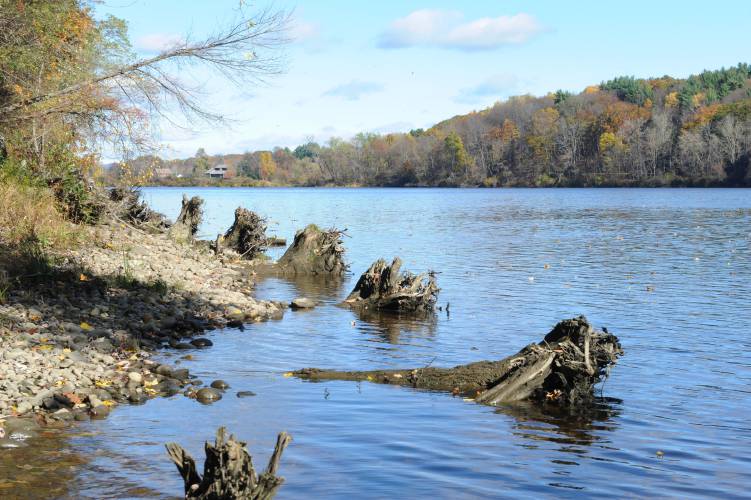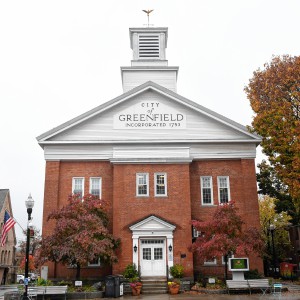My Turn: Mass. DEP and the fate of New England’s great river

The western bank of the Connecticut River in Gill across from the intake/outflow of the Northfield Mountain Pumped Storage Facility. STAFF FILE PHOTO/PAUL FRANZ
| Published: 12-09-2024 2:08 PM |
On Oct. 10, Tim Jones, acting director of the state Department of Environmental Protection’s Division of Waterways and Wetlands, presided over an “information” session in Turners Falls to field a skeptical public’s questions about its 401 Water Quality certification responsibilities under the Clean Water Act. For 51 years, FirstLight’s Northfield Mountain Pumped Storage Station has been reversing miles of current and killing fish by the millions on a three-state reach of the Connecticut. No agency or NGO ever challenged the operations pulling asunder the river’s ancient “continuous surface connection to a navigable water” downstream — the Atlantic Ocean. DEP’s looming decision in FirstLight’s Federal Energy Regulatory Commission license bid for NMPS could end the interstate carnage shared with Vermont and New Hampshire.
Canada’s $250 billion giant PSP Investments bought FirstLight and the Northfield and Turners Falls facilities in 2016, then reregistered them into Delaware tax shelters. In 2019, FirstLight reported one year’s sales from NMPS at $159 million. They’ve since spent hundreds of millions of dollars buying assets in Ontario, Quebec, New York and Pennsylvania, and opening a $97 million corporate loan facility.
Traditional hydropower supplies a fraction of this region’s energy. But NMPS is like hydro’s evil twin. It runs on grid electricity, wasting 34% more energy sucking in the river than it later sends out as a few hours of twice-generated juice. It’s unnecessary use in ISO New England’s grid is a huge environmental burden. That 34% plug-in loss will forever be its baseline waste. Further losses accrue in long-line transmission relays — i.e., the electricity imported to run its pumps, and further as FirstLight regenerates it into distant markets.
ISO New England’s market overwhelmingly runs via fracked gas and nuclear power, aiding the blind consumption fueling the climate emergency. Their chart is here: ISO New England - Real-Time Maps and Charts. NMPS’s buy-low/sell-high operation is essentially subsidized by ISO’s over-contracted electricity. FirstLight buys its bulk juice cheap, or even free at times, to turbo-suck the river. Massachusetts, ISO’s biggest consumer, keeps ramping up energy deficits for new online gaming, high-speed data centers, casinos, indoor marijuana grow factories, and metro-Boston’s glut of empty office towers. The state’s plan is to re-shackle a horrifically battered Connecticut in endless round-trip electricity relays from ocean turbines hundreds of miles away to FirstLight’s sucking turbines — to later resend a few hours’ juice back to big-consuming coastal cities.
NMPS also profits handily when not generating. ISO contracts with FirstLight to simply hold back several hours of water for possible emergency use. It’s a cheap, embedded insurance policy for the corporation-dominated “quasi-public” market that’s helped keep NMPS’s waste in play for decades. ISO ignores the security that distributed generation and micro-grids offer as ratepayers here enrich foreign investors, in the off-chance of the rarest of occurrences in their bloated market: a regional blackout. The last one occurred in 2003.
FirstLight’s October “annual generation summary” to FERC stated NMPS consumed 751 million gross kilowatt hours of electricity, to regenerate just 551 million GKHs. Their Turners Falls units generated “379 million gross kilowatt hours” of actual hydro. Subtracting 200 million GKHs lost in river suctioning, 53% percent of FL’s hydro was nullified by NMPS waste — reducing it to just 179 million GKH. In 2022 NMPS used 1,058 million GKH, to generate just 792, voiding nearly three-quarters of Turners Falls’ 310 million. In 2020 it chewed through 988 million GKHs to return 740, a 249 million loss erasing 75% percent of TF 305 million GKHs. Meanwhile, it’s massive vortex creates a netherworld of stalled, reversed and scrambled currents, where, at minimum, hundreds of millions of eggs, larvae and young-of-the-year fish from two dozen migratory and resident species perish annually.
FirstLight met privately with DEP this spring, along with MA Fish & Wildlife and MA Dept. of Conservation & Recreation. Upon request, DEP refused to supply meeting specifics. At October’s meeting FL managers sat facing DEP’s Jones and David Hilgeman. MA Fish & Wildlife’s Caleb Slater, Natural Heritage and Endangered Species Program’s Jesse Leddick and DCR’s Paul Jahnige filled out the panel—all from agencies that recently inked a sprawling, closed-door “flows and fish passage” settlement agreement with FL, as did US Fish & Wildlife and National Marine Fisheries. It’s now on FERC’ desk, six years past those license expiration dates.
Article continues after...
Yesterday's Most Read Articles
Thus, by October, Massachusetts agencies were already contractually committed to “request that MADEP accept and incorporate, without material modifications, as conditions to the Section 401 Certifications, all the PM&E measures,” (protection, mitigation, and enhancement). They’d pledged, “Upon notification by FirstLight of the need therefore, the other Parties shall provide written communications (or orally, in the event written communication is impossible to obtain due to reasons outside a Party’s control) of support in any administrative approval process that may be required for implementation of this Settlement Agreement.”
If DEP doesn’t deny or substantially modify that settlement’s grim conditions, and grants or “waives” the 401 WQ certificate required for licensing, the reversing flows and carnage in a crippled interstate river here will likely be cemented in place for a new half century. FERC historically rubber stamps settlements. Massachusetts will then have essentially usurped the jurisdictional rights of Vermont and New Hampshire. Neither was party to the secret deals. Ironically, both states have negotiated nature-like–exponentially-less-lethal, “run of river” flows with Vernon Dam owners—for downstream flow entering Massachusetts on New England’s Great River.
Karl Meyer lives in Greenfield.






 Connecting the Dots: It comes to us all
Connecting the Dots: It comes to us all Ira Helfand: A bomb survivors warn of nuclear danger
Ira Helfand: A bomb survivors warn of nuclear danger Michelle Spaziani: High municipal employee turnover merits immediate review
Michelle Spaziani: High municipal employee turnover merits immediate review My Turn: Massachusetts’ health system is failing
My Turn: Massachusetts’ health system is failing
